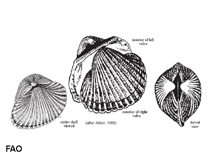Scapharca brasiliana (Lamarck, 1819)
Classification / Names Populärnamn | synonymer | CoL | ITIS | WoRMS
Bivalvia | Arcida | Arcidae
Environment: milieu / climate zone / djupintervall / distribution range Ekologi
; djupintervall 0 - 75 m (Ref. 83435). Tropical; 18°N - 18°N, 88°E - 88°E (Ref. 83435)
Distribution Länder | FAO områden | Ekosystem | Förekomster | Utplanteringar
Western Atlantic.
Length at first maturity / Size / Weight / Age
Könsmognad: Lm ? range ? - ? cm Max length : 4.1 cm DL hane/ej könsbestämd; (Ref. 83435); common length : 7.8 cm TL hane/ej könsbestämd; (Ref. 344)
Short description Morfologi
Life cycle and mating behavior Könsmognad | Reproduktion | Lek | Eggs | Fecundity | Larvae
Main reference
referenser | Koordinator | Medarbetare
Leal, J.H. 2003 Bivalves. p. 25-98. In Carpenter, K.E. (ed.). The living marine resources of the Western Central Atlantic. Volume 1: Introduction, molluscs, crustaceans, hagfishes, sharks, batoid fishes, and chimaeras. FAO Species Identification Guide for Fishery Purposes and American Society of Ichthyologists and Herpetologists Special Publication No. 5. 1600p. (Ref. 344)
IUCN Red List Status
(Ref. 130435: Version 2025-1)
CITES status (Ref. 108899)
CMS (Ref. 116361)
Threat to humans
Human uses
| FishSource |
Verktyg
Ytterligare information
Max. ages / sizes
Length-weight rel.
Length-length rel.
Length-frequencies
Mass conversion
Abundans
Internet-källor
BHL | BOLD Systems | CISTI | DiscoverLife | FAO(Publication : search) | Fishipedia | GenBank (genome, nucleotide) | GloBI | Gomexsi | Google Books | Google Scholar | Google | PubMed | Tree of Life | Wikipedia (Go, sök) | Zoological Record



